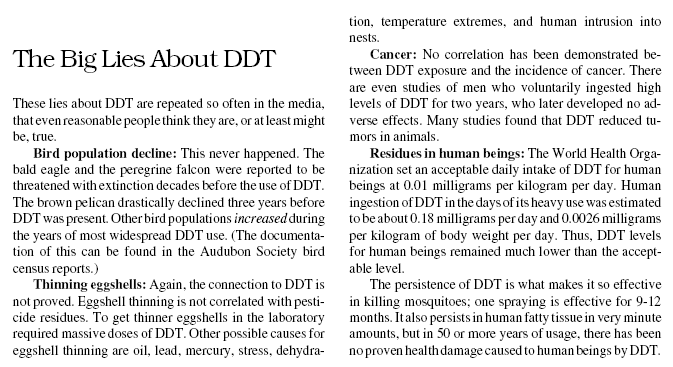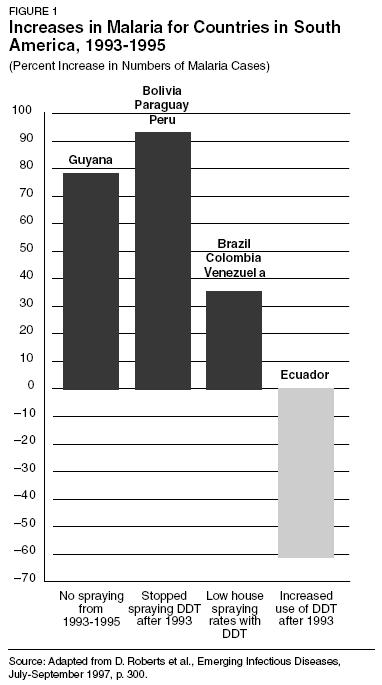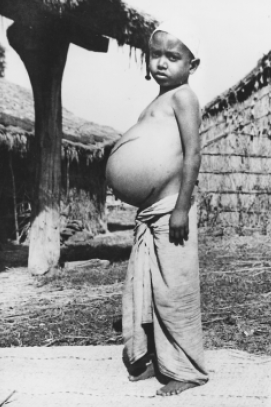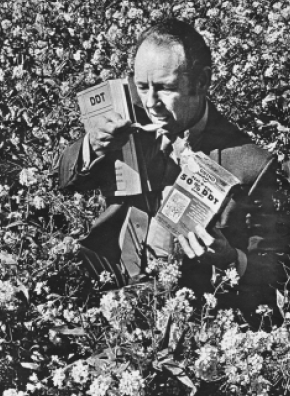|
|
|
by Marjorie Mazel Hecht June 18, 2004 from LaRouchePub Website
Muhwezi dismissed the critics of DDT, saying,
Muhwezi also noted that the country of
Mauritius was about to be declared malaria free because of its use
of DDT.
When the Konkola Copper Mines began
spraying the inside walls of houses with DDT, there was a 50%
reduction of malaria in one year. The next year, there was a further
50% reduction, and since then there have been no malaria deaths in
that region.
He told the Bulawayo Chronicle in October 2003,
In Kenya, the DDT fight is still on, with the director of Kenya's premier research institute, KEMRI, taking a strong stand for the use of DDT, and another research institute, the International Center of Insect Physiology and Ecology, taking the anti-DDT, environmentalist view.
Malaria now kills 700 Kenyans a day, and as KEMRI director Davy Koech told the opposition,
Kenya had a terrible outbreak of malaria after heavy rains in 2002, with hundreds of deaths.
According to the
group Doctors without Borders, there are about 8.2 million cases of
malaria reported in Kenya per year. The epidemic-prone areas are the
highlands, where about 23% of the population lives.
In 1996, South Africa had substituted a synthetic pyrethroid insecticide for DDT, under pressure from environmentalists. But the mosquitoes became resistant to this pesticide.
As a result, between 1996 and 2000, the number of malaria
cases in South Africa increased by more than 450%, with an increased
mortality rate of nearly 1,000%!
Anti-malarial sprying
in Guyana. The British medical journal The Lancet reported that no
The DDT program for malaria control has the support of South Africa's leading researchers, doctors, and malaria control experts, who released a statement in April 2004 backing the indoor spraying program, and slamming the latest permutation in the DDT scare stories, that DDT lowers sperm levels and quality.
The statement notes,
Killed by the Big Lie
But such an assumption overlooks the
huge aura of fear and ignorance about DDT, built up by the
Malthusian lobby over the past 35 years. The very word "DDT" is
enough to invoke terror today among the ignorant and gullible - and
also some of the well-meaning.
The EPA hearing examiner, Edmund Sweeney, ruled, on the basis of the scientific evidence, that DDT should not be banned.
But two months later, without even
reading the testimony or attending the hearings, EPA administrator
William Ruckelshaus overruled the EPA hearing officer and banned
DDT. He later admitted that he made the decision for "political"
reasons.
The U.S. Agency for International Development stopped supporting programs involving DDT (and instead increased funding for birth control programs).
Other industrial nations did the same.
Instead, they gave up DDT.
The malaria-carrying mosquitoes were the immediate beneficiaries, and malaria soon became Africa's largest killer, only more recently to be equaled by AIDS. There are an estimated 300-500 million new cases of malaria per year now, 90% of which are in Africa.
There are 2.7 million deaths from malaria per year, mostly those of children under 5 years old.
Source: Adapted from
the British Medical Journal, May 8, 2004. when the Roll Back Malaria campaign was initiated. It promised to halve the number of malaria deaths by 2010, and a United Nations resolution declared 2001-2010 “the Decade to Roll Back Malaria, especially in Africa.”
But the toll of malaria is not measured simply in deaths. Malaria is a terrible disease, sapping the strength of those who do not die, making them feverish, chilled, with repeated vomiting, and too sick and weak to work or farm.
Malaria overburdens the limited health
systems of poor countries, and ruins their economies.
Too Many Lives Saved?
The U.S. National Academy of
Sciences estimated that DDT had prevented 500 million human deaths
from malaria, since it came into use during World War II. Millions
of troops and refugees would have died from disease at the end of
the war, had they not been dusted with DDT to kill the body lice
that spread typhus.
Why was DDT banned, after such spectacular success?
The reason was given bluntly by Alexander King, founder of the Malthusian Club of Rome, who wrote in a biographical essay in 1990,
The DDT battle in Africa today is still against that Malthusian outlook expressed so bluntly by Alexander King.
Today, however, most of the opponents of DDT don't openly argue that we should kill off the "surplus" people; instead they argue that we must protect the environment, keep Africa pristine.
In the words of one Ugandan living in Toronto, writing an open letter to Uganda's President against the use of DDT:
This market argument is expressed by DDT
opponents throughout the region: European restrictions on pesticide
residues mean that African countries will have to monitor for
chemical residues - and lose export markets for all kinds of exports,
including fish and tobacco, if there are DDT residues.
There is no DDT sprayed outside. As studies have shown, the mosquito vectors that carry malaria (in South Africa it is Anopheles funestus) rest on the inside house walls and bite human beings at night.
These mosquitoes either are killed by contact with DDT on the sprayed wall, or repelled by the DDT, and do not stay around to bite the inhabitants.
A typical malaria
victim in 1950, before DDT was widely used. one of the symptoms of malaria infection.
This latter effect is known as "excito-repellency," and has been shown to be a dominant way that DDT controls malaria-bearing mosquitoes, in addition to killing them on contact.[1]
Morally, the save-the-environment-and-forget-the-people argument is outrageous.
The First Secretary at the Washington Embassy of one large African nation, said,
He recalled the 1960s, when he was growing up in Africa, when DDT was in use and had completely wiped out mosquitoes and malaria in his region.
(For the moment, we will leave aside the question of drug treatment for people with malaria, and the need for public health infrastructure.)[2]
These organizations and other donor groups came up with the idea of stopping malaria by promoting the distribution of bed nets impregnated with insecticides. No insect control measures, no swamp draining, no infrastructure improvement, no personnel training or increase in public health facilities, just bed nets.[3]
The goal of Roll-Back Malaria in 1998
was to halve the deaths from malaria by the year 2010. As the
increase in malaria throughout Africa testifies, this program has
been an abysmal failure.
Roger Bate and Richard Tren of Africa Fighting Malaria note that DDT leaves a powdery residue on the walls, and that it is not effective on plastered and painted walls, just on clay, cement, wood, or thatch walls.
Also in some
places, bedbugs have developed a resistance to it. As Bate and Tren
point out, alternative pesticides can be used either along with DDT,
to combat the bedbugs, or alone where the housing is more
Western-style than traditional African, with painted walls.
UNEP proposed to institute "legally binding" international controls banning what are called "persistent organic pollutants" or POPS, including DDT.
The environmental pressure groups agitated for a complete ban on DDT use, but the final treaty permitted emergency public health exceptions, with the idea that its use will be phased out in the future. In May 2004, the POPS treaty went into effect, known officially as the Stockholm Convention on Persistent Organic Pollutants.
However, 29 nations (almost all in
tropical regions) requested and secured an exemption for DDT use for
disease control, and three nations received an exemption to produce
DDT for public health use (China, India, and Russia).
The usual chorus of World Wildlife/Greenpeace polemics against man-made "poisons," has been augmented with a new, more desperate round of scare stories, the latest focusing on semen quality.
Ironically, the same Malthusians who
want to stop DDT and reduce population growth, are now complaining
(without proof) that DDT reduces and damages semen!
As one U.S. malaria expert told me,
In fact, these groups exert tremendous
pressure on African political and health figures who support DDT.
Much of this pressure takes the form of spreading old and new lies
about DDT to scare people.
Even The New York Times in its Sunday Magazine on April 11, 2004, featured the benefits of DDT in an article by editorial board member Tina Rosenberg, titled "What the World Needs Now Is DDT." (To my knowledge, this is the first time in 35 years that The New York Times has said anything favorable about DDT.)
Rosenberg argues that because we successfully used DDT to eliminate malaria and other mosquito-borne diseases in the West,
There are also some groups, notably Africa Fighting Malaria, that have championed DDT as a major weapon in combating malaria. But their material is largely confined to publication in the conservative press, which limits its circulation.
Entomologist J.
Gordon Edwards, featured in Esquire magazine
To win the fight against the killer malaria, the African nations need broad-based support from the United States and other Western nations, both financial and political.
We can begin by calling the anti-DDT lobby by its proper name: Genocidalists.
And we can stop tolerating the ignorance and anti-science of the so-called public, and their elected officials, which allows these genocidalists to remain in control of public opinion.
For Further Reading
|







